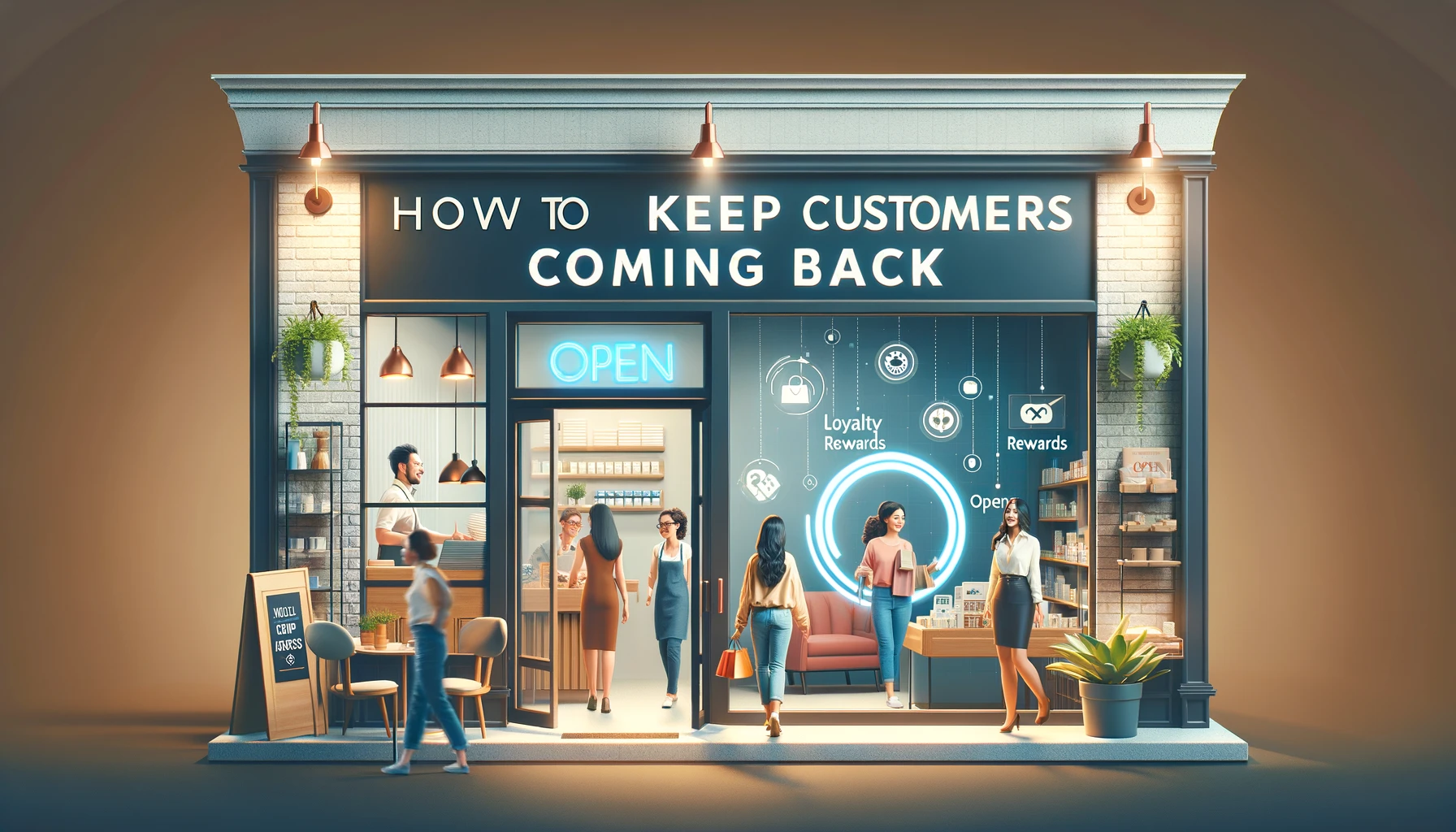Table of Contents
Keeping Customers Coming Back: The Key to Business Success
Keeping customers coming back is crucial for the success of any business. To achieve this, it’s essential to provide excellent products or services, outstanding customer service, and build strong relationships with your customers.
When customers have a positive experience and feel valued, they’re more likely to return, become loyal supporters, and even recommend your business to others. By focusing on delivering quality and building trust, you can create a loyal customer base that keeps coming back for more of what you offer.
How to Keep Customers Coming Back?
Once your business achieves its initial goals and builds a robust customer base, the focus shifts from merely attracting new customers to ensuring the existing ones remain loyal and engaged. This involves understanding their needs, consistently delivering value, and creating experiences that make them eager to return.
15 Tips to Know What Keeps Customers Coming Back
- Provide Excellent Customer Service: Exceptional customer service is the cornerstone of customer retention. Always respond promptly to inquiries, resolve issues quickly, and go the extra mile to help customers. Friendly and helpful interactions leave a lasting positive impression, making customers more likely to return.
- Offer Loyalty Programs: Implementing a loyalty program rewards repeat customers with points, discounts, or exclusive offers. These programs incentivize continued purchases and make customers feel appreciated. A well-structured loyalty program can significantly increase repeat business.
- Personalize the Shopping Experience: Use customer data to personalize their experience. This can include product recommendations based on past purchases, personalized emails, and special offers tailored to their preferences. Personalization makes customers feel valued and understood, enhancing their shopping experience.
- Send Follow-Up Emails: After a purchase, send a thank-you email and ask for feedback. Follow up with personalized recommendations and exclusive offers to keep customers engaged. Consistent, thoughtful communication helps maintain a connection with customers, encouraging them to return.
- Create a Seamless User Experience: Ensure your website is user-friendly, mobile-responsive, and provides a smooth checkout process. A well-designed, easy-to-navigate site enhances the shopping experience, reducing the likelihood of cart abandonment and increasing the chances of repeat visits.
- Offer High-Quality Products: Consistently providing high-quality products is essential for customer satisfaction. When customers know they can rely on your store for quality, they are more likely to return and recommend your store to others. Quality products build trust and loyalty.
- Engage on Social Media: Maintain an active presence on social media platforms. Share valuable content, respond to comments, and engage with your audience. Social media engagement builds a community around your brand, keeping customers connected and informed about your latest offerings.
- Implement Customer Feedback: Actively listen to customer feedback and make improvements based on their suggestions. Showing that you value their input and are willing to make changes can build strong loyalty. Customers appreciate when their voices are heard and acted upon.
- Provide Exceptional Post-Purchase Support: Offer excellent support after the sale, such as easy returns and exchanges, clear instructions for product use, and responsive customer service. Exceptional post-purchase support reassures customers that you care about their satisfaction beyond the initial sale.
- Use Retargeting Ads: Utilize retargeting ads to remind previous visitors about your store and products. These ads can re-engage customers who have shown interest in your products but didn’t complete a purchase, encouraging them to return and buy.
- Offer Free Shipping: Free shipping is a significant incentive for customers. Consider offering it for orders over a certain amount. The perceived value of free shipping can lead to increased sales and repeat business, as customers are more likely to return for the same benefit.
- Create a Sense of Community: Build a community around your brand through forums, social media groups, or events. Engaging with your customers in a community setting fosters a sense of belonging and loyalty. Customers who feel part of a community are more likely to stay loyal to your brand.
- Keep Your Customers Informed: Regularly update customers with newsletters or notifications about new products, special promotions, and company news. Keeping customers informed and engaged with your brand helps maintain their interest and encourages repeat visits.
- Offer Exclusive Deals: Provide returning customers with exclusive deals or early access to sales. Making them feel special with offers they can’t find elsewhere boosts loyalty. Exclusive deals show appreciation for their continued support.
- Show Appreciation: Show appreciation to your customers through thank-you notes, surprise discounts, or special gifts. Small gestures of gratitude can make a big difference in customer retention. Appreciated customers are happy customers, and happy customers keep coming back.
Customer retention refers to the ability of a company to retain its customers over a specified period. It is a key metric that indicates how well a business can keep its customers returning to make repeat purchases. High customer retention means that customers are satisfied with the products, services, and overall experience provided by the business.
Importance of Customer Retention
- Cost Efficiency: Retaining existing customers is more cost-effective than acquiring new ones. The cost of marketing and promotions to attract new customers is significantly higher compared to the cost of maintaining relationships with current customers.
- Increased Profits: Loyal customers are more likely to make repeat purchases, leading to higher sales and revenue. They may also spend more per transaction compared to new customers.
- Positive Word-of-Mouth: Satisfied customers are more likely to recommend your business to others. This word-of-mouth promotion is invaluable and can lead to new customer acquisitions at no additional cost.
- Feedback for Improvement: Retained customers often provide valuable feedback that can help you improve your products and services. This feedback loop ensures continuous improvement and keeps your offerings aligned with customer needs.
- Brand Loyalty: A high retention rate indicates strong brand loyalty. Loyal customers are less likely to be swayed by competitors and are more forgiving of occasional issues or mistakes.
As Sam Walton, the founder of Walmart, wisely said, “There is only one boss. The customer. And he can fire everybody in the company from the chairman on down, simply by spending his money somewhere else.” This underscores the immense power of customer satisfaction in driving the long-term success of your business.
By focusing on delivering quality and building trust, you can create a loyal customer base that keeps coming back, ensuring sustained growth and success for your business.
Bottom Line
Keeping customers coming back is essential for long-term business success. It involves consistently delivering high-quality products and exceptional customer service while building strong relationships. When customers feel valued and have positive experiences, they are more likely to become loyal, make repeat purchases, and recommend your business to others.
By focusing on customer retention through strategies like personalized experiences, loyalty programs, effective communication, and prompt support, you can create a dedicated customer base. This not only enhances your business’s financial health but also fosters a community of satisfied customers who contribute to sustained growth and profitability. Prioritize customer satisfaction and trust, and you’ll see your business thrive with a loyal following.
FAQs
1.How do you attract customers back?
Attracting customers back involves using personalized marketing, such as sending tailored emails and special offers based on past purchases. Implementing loyalty programs that reward repeat customers with discounts and exclusive perks also helps. Providing exceptional customer service, offering special promotions, and creating engaging content can further entice customers to return.
2.How to convince a customer to come back?
To convince a customer to come back, follow up with them through thank-you emails and exclusive deals. Personalize your communication by addressing them by name and referencing their previous purchases. Offer incentives like discounts or loyalty points, ensure they had a superior experience, and request feedback to show you value their input.
3.What is a good returning customer?
A good returning customer is typically defined by a high repeat purchase rate, often around 20-30% or higher. This indicates that a significant portion of customers consistently return to make additional purchases, demonstrating strong loyalty, satisfaction, and engagement with your brand. Achieving this benchmark means your business effectively delivers quality and maintains customer relationships, contributing to steady revenue and reducing customer acquisition costs.
4.How do you create a returning customer?
Creating a returning customer involves delivering consistent quality in your products and services, providing exceptional customer service, and regularly engaging with them through emails and social media. Making the shopping experience seamless and convenient, along with building strong, personalized relationships, also plays a crucial role.
5.How to increase repeat sales?
To increase repeat sales, promote and reward loyalty programs, offer personalized discounts and deals, and ensure a smooth and enjoyable shopping experience. Maintaining high product quality and keeping in regular contact with customers through engaging content and updates also encourages repeat business.


 Integrated Supplier Network
Integrated Supplier Network



